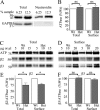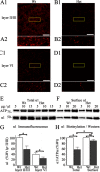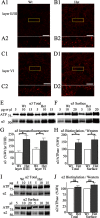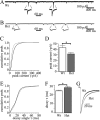Altered cortical GABAA receptor composition, physiology, and endocytosis in a mouse model of a human genetic absence epilepsy syndrome
- PMID: 23744069
- PMCID: PMC3774412
- DOI: 10.1074/jbc.M112.444372
Altered cortical GABAA receptor composition, physiology, and endocytosis in a mouse model of a human genetic absence epilepsy syndrome
Abstract
Patients with generalized epilepsy exhibit cerebral cortical disinhibition. Likewise, mutations in the inhibitory ligand-gated ion channels, GABAA receptors (GABAARs), cause generalized epilepsy syndromes in humans. Recently, we demonstrated that heterozygous knock-out (Hetα1KO) of the human epilepsy gene, the GABAAR α1 subunit, produced absence epilepsy in mice. Here, we determined the effects of Hetα1KO on the expression and physiology of GABAARs in the mouse cortex. We found that Hetα1KO caused modest reductions in the total and surface expression of the β2 subunit but did not alter β1 or β3 subunit expression, results consistent with a small reduction of GABAARs. Cortices partially compensated for Hetα1KO by increasing the fraction of residual α1 subunit on the cell surface and by increasing total and surface expression of α3, but not α2, subunits. Co-immunoprecipitation experiments revealed that Hetα1KO increased the fraction of α1 subunits, and decreased the fraction of α3 subunits, that associated in hybrid α1α3βγ receptors. Patch clamp electrophysiology studies showed that Hetα1KO layer VI cortical neurons exhibited reduced inhibitory postsynaptic current peak amplitudes, prolonged current rise and decay times, and altered responses to benzodiazepine agonists. Finally, application of inhibitors of dynamin-mediated endocytosis revealed that Hetα1KO reduced base-line GABAAR endocytosis, an effect that probably contributes to the observed changes in GABAAR expression. These findings demonstrate that Hetα1KO exerts two principle disinhibitory effects on cortical GABAAR-mediated inhibitory neurotransmission: 1) a modest reduction of GABAAR number and 2) a partial compensation with GABAAR isoforms that possess physiological properties different from those of the otherwise predominant α1βγ GABAARs.
Keywords: Brain; Confocal Microscopy; Electrophysiology; Endocytosis; Endoplasmic Reticulum (ER); Epilepsy; GABA Receptors; Glycosylation; Membrane Trafficking; Western Blotting.
Figures










Similar articles
-
Altered intrathalamic GABAA neurotransmission in a mouse model of a human genetic absence epilepsy syndrome.Neurobiol Dis. 2015 Jan;73:407-17. doi: 10.1016/j.nbd.2014.10.021. Epub 2014 Nov 4. Neurobiol Dis. 2015. PMID: 25447232 Free PMC article.
-
Altered thalamic GABAA-receptor subunit expression in the stargazer mouse model of absence epilepsy.Epilepsia. 2014 Feb;55(2):224-32. doi: 10.1111/epi.12500. Epub 2014 Jan 13. Epilepsia. 2014. PMID: 24417662
-
Agonist-dependent endocytosis of γ-aminobutyric acid type A (GABAA) receptors revealed by a γ2(R43Q) epilepsy mutation.J Biol Chem. 2013 Sep 27;288(39):28254-65. doi: 10.1074/jbc.M113.470807. Epub 2013 Aug 9. J Biol Chem. 2013. PMID: 23935098 Free PMC article.
-
Molecular Pathogenic Basis for GABRG2 Mutations Associated With a Spectrum of Epilepsy Syndromes, From Generalized Absence Epilepsy to Dravet Syndrome.JAMA Neurol. 2016 Aug 1;73(8):1009-16. doi: 10.1001/jamaneurol.2016.0449. JAMA Neurol. 2016. PMID: 27367160 Free PMC article. Review.
-
Subtype Selective γ-Aminobutyric Acid Type A Receptor (GABAAR) Modulators Acting at the Benzodiazepine Binding Site: An Update.J Med Chem. 2020 Apr 9;63(7):3425-3446. doi: 10.1021/acs.jmedchem.9b01312. Epub 2019 Dec 5. J Med Chem. 2020. PMID: 31738537 Review.
Cited by
-
Altered intrathalamic GABAA neurotransmission in a mouse model of a human genetic absence epilepsy syndrome.Neurobiol Dis. 2015 Jan;73:407-17. doi: 10.1016/j.nbd.2014.10.021. Epub 2014 Nov 4. Neurobiol Dis. 2015. PMID: 25447232 Free PMC article.
-
Artificial sleep-like up/down-states induce synaptic plasticity in cortical neurons from mouse brain slices.Front Cell Neurosci. 2022 Oct 14;16:948327. doi: 10.3389/fncel.2022.948327. eCollection 2022. Front Cell Neurosci. 2022. PMID: 36313618 Free PMC article.
-
An expanded parenchymal CD8+ T cell clone in GABAA receptor encephalitis.Ann Clin Transl Neurol. 2020 Feb;7(2):239-244. doi: 10.1002/acn3.50974. Epub 2020 Jan 14. Ann Clin Transl Neurol. 2020. PMID: 31943946 Free PMC article.
-
Metabolic modulation of synaptic failure and thalamocortical hypersynchronization with preserved consciousness in Glut1 deficiency.Sci Transl Med. 2022 Oct 5;14(665):eabn2956. doi: 10.1126/scitranslmed.abn2956. Epub 2022 Oct 5. Sci Transl Med. 2022. PMID: 36197967 Free PMC article.
-
GABA facilitates spike propagation through branch points of sensory axons in the spinal cord.Nat Neurosci. 2022 Oct;25(10):1288-1299. doi: 10.1038/s41593-022-01162-x. Epub 2022 Sep 26. Nat Neurosci. 2022. PMID: 36163283 Free PMC article.
References
-
- Shu Y., Hasenstaub A., McCormick D. A. (2003) Turning on and off recurrent balanced cortical activity. Nature 423, 288–293 - PubMed
-
- Lüttjohann A., Zhang S., de Peijper R., van Lijtelaar G. (2011) Electrical stimulation of the epileptic focus in absence epileptic WAG/Rij rats. Assessment of local and network excitability. Neuroscience 188, 125–134 - PubMed
-
- Badawy R. A., Jackson G. D. (2012) Cortical excitability in migraine and epilepsy. A common feature? J. Clin. Neurophysiol. 29, 244–249 - PubMed
-
- Fedi M., Berkovic S. F., Macdonell R. A., Curatolo J. M., Marini C., Reutens D. C. (2008) Intracortical hyperexcitability in humans with a GABAA receptor mutation. Cereb. Cortex 18, 664–669 - PubMed
Publication types
MeSH terms
Substances
Grants and funding
LinkOut - more resources
Full Text Sources
Other Literature Sources
Molecular Biology Databases

